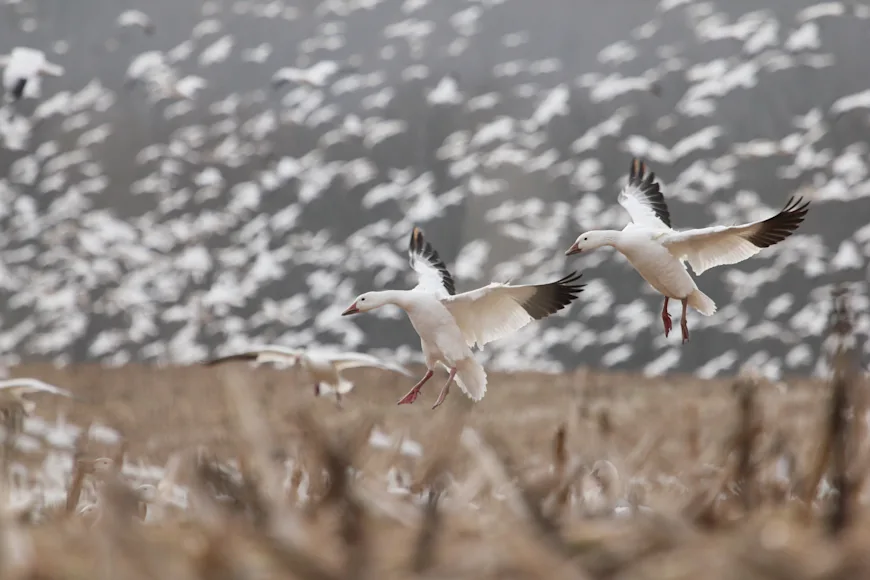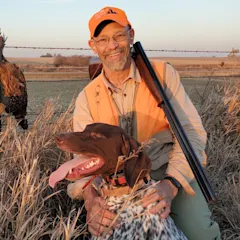We may earn revenue from the products available on this page and participate in affiliate programs. Learn more ›
Snow goose hunting season is not far off and can't come soon enough. Duck season is either over or nearly over for most of us. Canada geese are already closed in most states. What better cure for waterfowl withdrawal than to put yourself underneath a few thousand snow geese? Light goose season now runs into the spring in much of the Atlantic, Mississippi, and Central flyways.
Wherever you do it, snow goose hunting takes work. Like all goose hunting, it starts with lots of scouting. There are big decoy spreads to set, often in muddy fields. On the other hand, there are no bag or possession limits, and you can use unplugged guns and electronic callers. So, if you put in the effort, the reward can be a high-volume hunt you never knew existed right near home. Here’s what you need to know to get started snow goose hunting.
Snow Goose Hunting Table of Contents
What Are “White” or “Light” Geese?
Where to go Snow Goose Hunting
How to Set Out a Decoy Spread for Snow Goose Hunting
The Best Light Goose Decoys for Every Budget
The Best Blinds for Snow Goose Hunting
The Best Electronic Callers for Snow Goose Hunting
The Best Ammunition for Snow Goose Hunting
The Best Shotguns for Snow Goose Hunting
Frequently Asked Questions
What Are “White” or “Light” Geese?
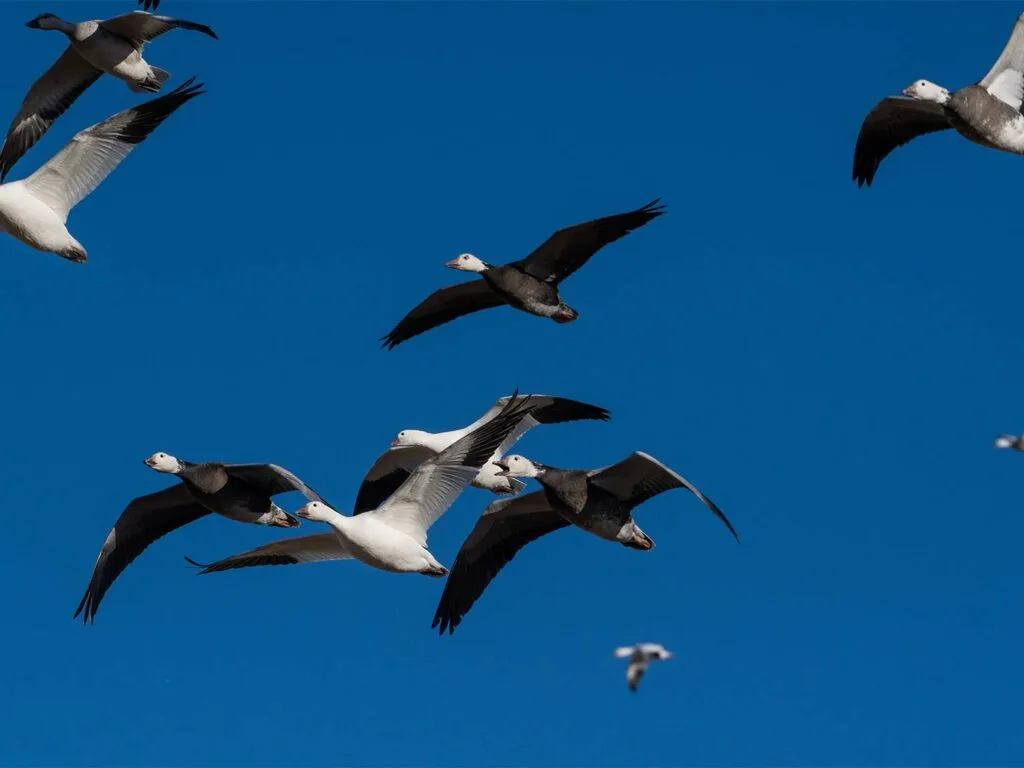
“White” or “light” geese refers generally to two species of snow geese and to Ross’s geese. “Light” is the technically correct term, but people use both interchangeably. The Atlantic Flyway is home to greater snow geese. Slightly smaller lesser snow geese and duck-sized Ross’s geese make up the flocks of the Mississippi and Central Flyways. A blue color phase is quite common among lessers. Almost all Ross’s geese pure white and mature birds have distinct caruncled bills. Juvenile snows and Ross’s are gray.
All three species breed in the far north, from Hudson Bay to the Arctic, and make a long journey to their wintering grounds. Lessers and Ross’s geese winter from Arkansas to the Gulf Coast, while greaters stop along the mid-Atlantic coast.
Light geese evolved to feed on tubers and marsh plants, but the wholesale conversion of land to agricultural crops in the United States and Canada improved their diet to the point where they return to the breeding grounds fat, healthy, and ready to overpopulate the fragile tundra. The special conservation order season intended to reduce populations began in 1999 and remains in effect, which is why you can go goose hunting in the spring.
Where to go Snow Goose Hunting
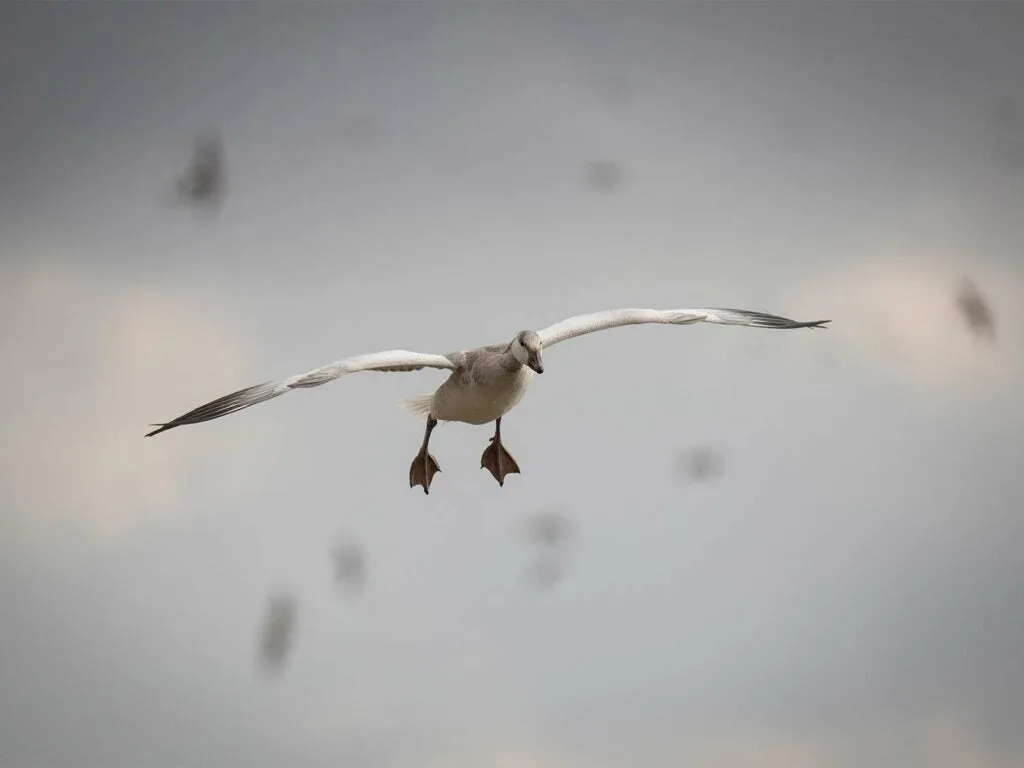
Restless migrators, snow geese stay just below the snowline as they head north in the spring. Days with southerly winds are migration days, while a north wind or bad weather may prompt short reverse migrations. Snows will stage by the tens of thousands when the weather holds them up, and it’s possible to scout and hunt feed fields just as you would in the fall. As you scout, bear in mind that snows think nothing of flying 20 to 25 miles out to feed. You can set up either on the X field, or on the flight lines between the feed and the roost.
Putting out a decoy spread in a grain field along a migration corridor and trafficking northbound or reverse migrators is very effective, and it works best when you can pick a high spot for maximum visibility. If you can find a pond by a grain field on the flightline, set a field-and-water spread. You’ll lure tired birds late in the day as they look for a place to feed a bit and rest overnight.
How to Set Out a Decoy Spread for Snow Goose Hunting
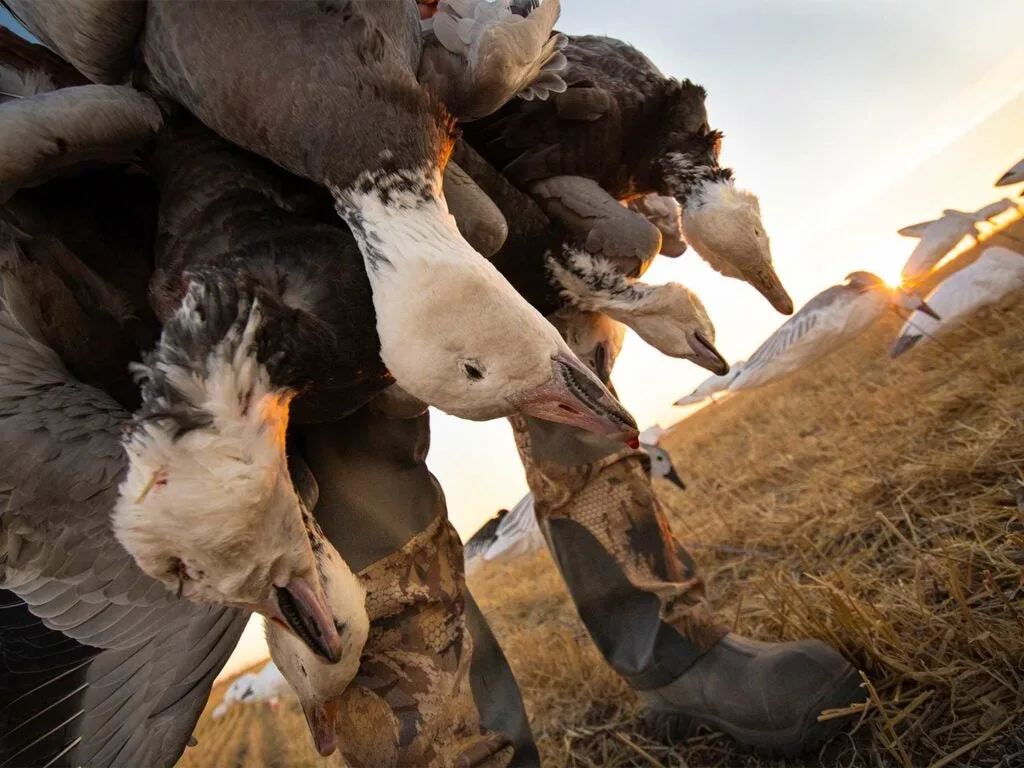
Quintessential birds of a feather, all snow geese do is flock together. On a flight day, you’ll see skeins of geese stretching from horizon to horizon. It’s an awe-inspiring sight. On a practical note, it means it takes a lot of decoys to impress traveling snows. Spreads of over 1,000 decoys are common, but three hundred set in the right place at the right time work, too.
Start small. If you and a few friends all chip in on decoys you’ll have enough to start out. You can add a few every year, because snow goose sickness is a disease you’ll have for a long time.
Set decoys in a teardrop shape with the point aimed downwind and a landing hole where the tear begins to narrow. Pack the decoys so tightly in the upwind portion that it’s hard to walk through them, but space the birds in the point farther apart. The whole spread might measure 100 to 150 yards from front to back. Geese will key on the point and follow it right up to the landing hole. Hide blinds among the tightly packed decoys upwind of the landing hole, but be ready to move them to the side if geese are seeing them, or even downwind if the birds are sliding off the spread short of the landing zone.
The Best Light Goose Decoys for Every Budget
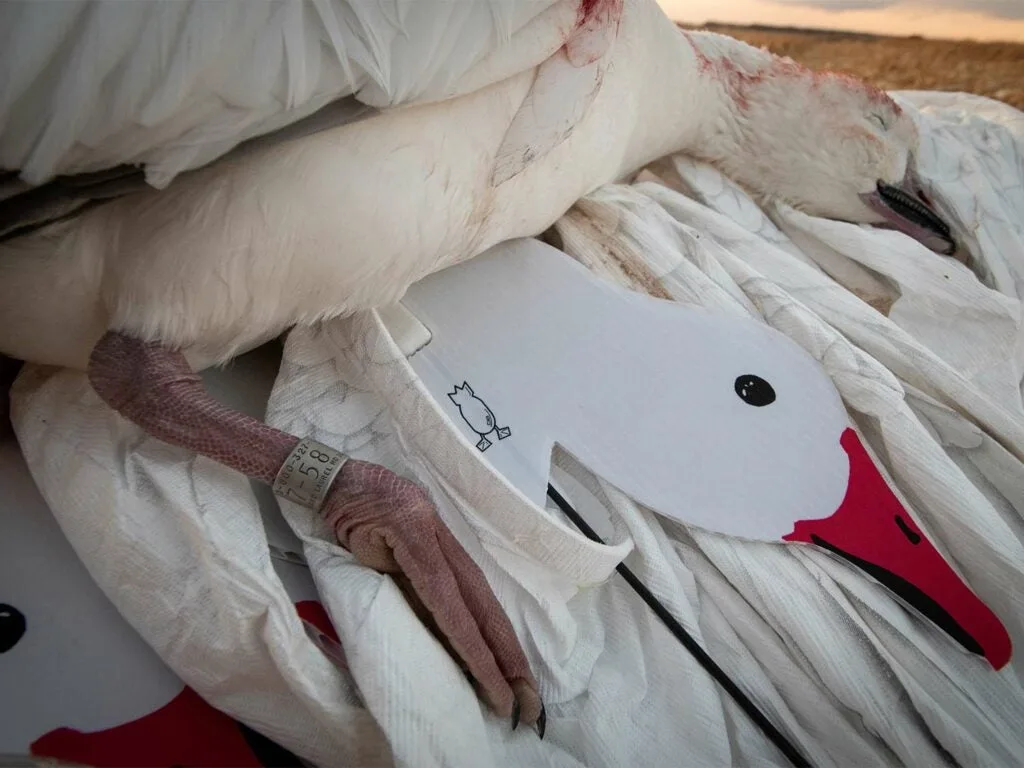
When you hunt the greater snow geese of the Atlantic flyway, you’ll want primarily white decoys with some gray juveniles mixed in. The lesser snow geese of the Mississippi and Central flyways come in both white and the blue color phase. About 70 percent white geese, 30 percent blues make a good mix of adult decoys, which should make up about two thirds of the spread. The rest should be gray juveniles. If you have to err, err on the side of white decoys, which show up best.
Best Full-Body Snow Goose Hunting Decoys: Banded/GHG Full Body Decoys
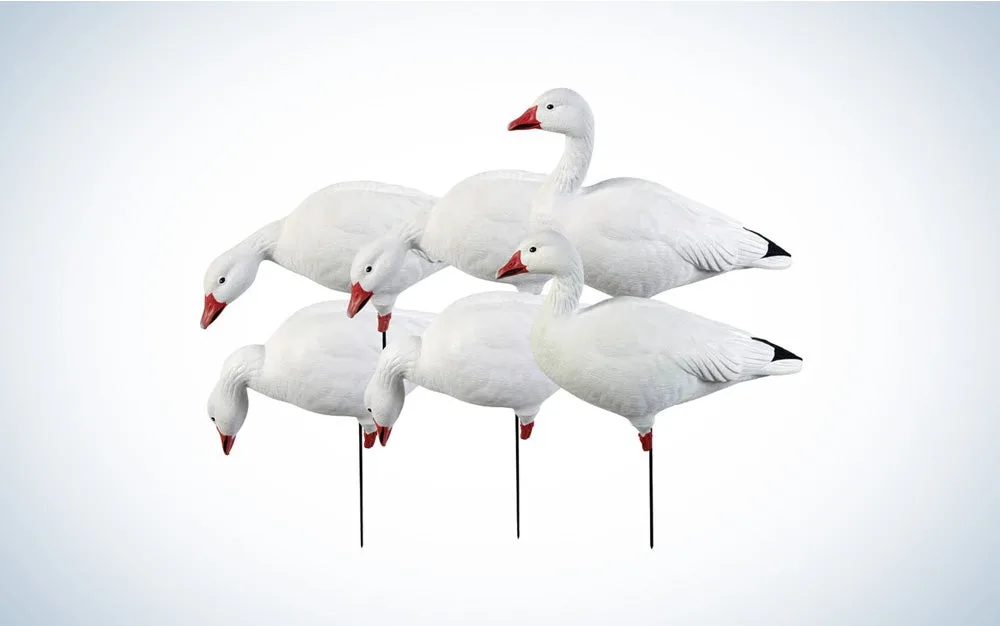
Full bodies provide the ultimate in realism, which can matter because adult snow geese are wary, and fooling a flock of 1,000 birds means you have 2,000 eyes to deceive. Full bodies require serious commitment, and they aren’t cheap. You’ll need a trailer or maybe two to haul them all. And forget decoy bags—you’ll use giant feed sacks instead. Hunting with full bodies is a major production.
Budget Snow Goose Hunting Decoys: Dive Bomb Snow Goose Windsocks
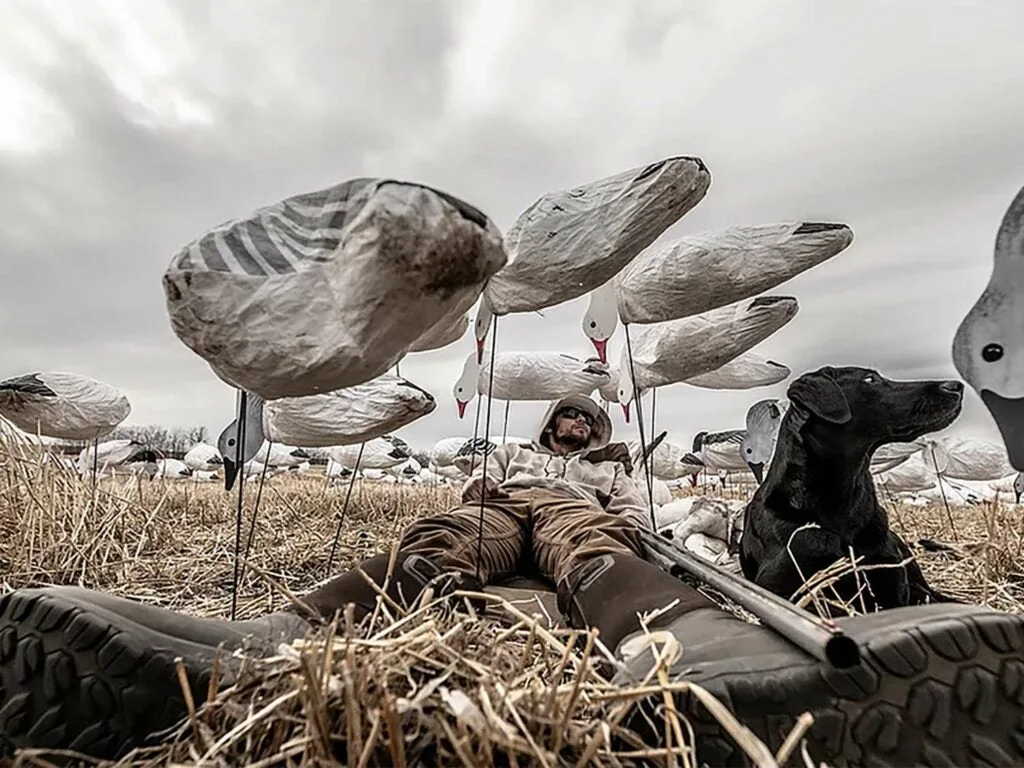
Windsocks are affordable, they move in the wind, and you can fit 10 dozen in a bag, which means a spread fits in the back of a pickup. Dive Bomb Industries sells quality snow goose windsocks in short- and long-stake versions for around $65 per dozen.
Snow Goose Hunting Motion Decoys: Sillosock Flyers
Feeding snow geese move. They walk. They hop over one another to get to food. Include some motion in your spread. Sillosock flyers, $25 each, come on a 3-foot stake and flap their wings in a breeze. You’ll want some, and regular hand-held goose flags, too, for days when the wind dies.
The Best Blinds for Snow Goose Hunting
Hiding matters with snow geese. The current trend is to wear whites and lay out on a back rest underneath long-stake windsocks. Hiding under socks works best on sunny days when it’s not miserable out and the shadows of the windsocks overhead make you invisible.
Layout blinds can work great in a field if there’s enough stubble to hide them. They work best cloudy days when they don’t throw shadows, and they are more comfortable when it’s cold and windy. Whichever you choose, experiment with hunting from different parts of the spread so you’re not directly in the approaching flock’s line of sight.
Deluxe Choice: Finisher Layout Blind
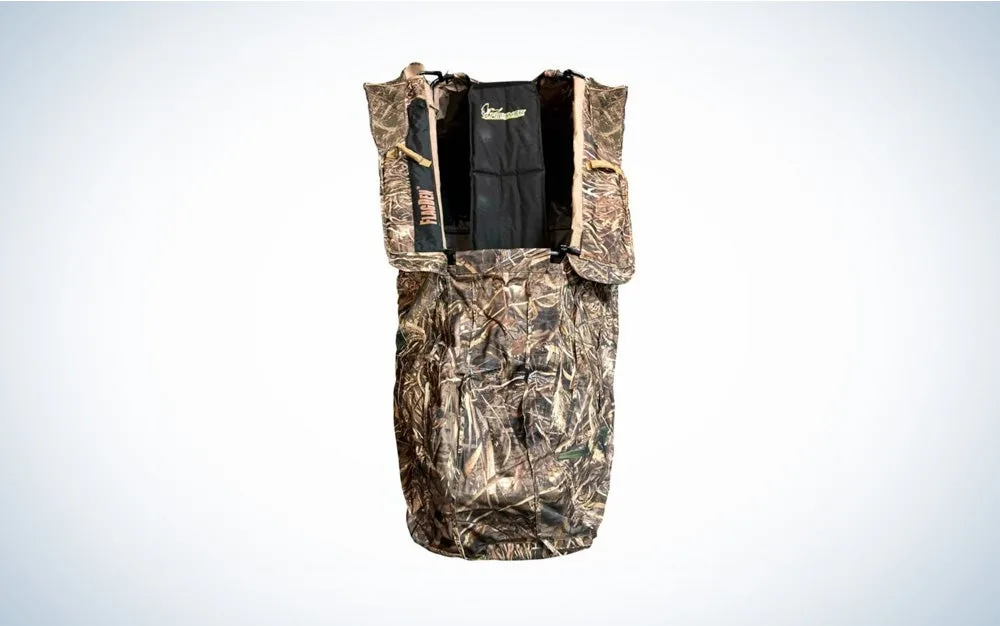
One of the first and still one of the best layout blinds, the Finisher sets up and breaks down quickly, and it’s a comfortable place to spend a day watching clouds of geese pass overhead.
Budget Choice: Tanglefree Dirt Ghost Blind

Light and simple, the Dirt Ghost Blind works as a backrest for hunting in whites, or as a layout blind with its detachable boot bag that you can pull up to cover yourself with.
The Best Electronic Callers for Snow Goose Hunting
In the days before electronic callers, if you shot 20 or 30 spring snow geese in a day you told people about it. Electronic callers make 100-bird days possible.
Use one or two callers in a smaller spread and up to four in a big spread. Like all calling, electronic calling involves trial and error. Watch birds react and be ready to adjust the volume up or down if they’re not finishing.
Deluxe Choice: Fox Pro Snow Pro Digital Game Call
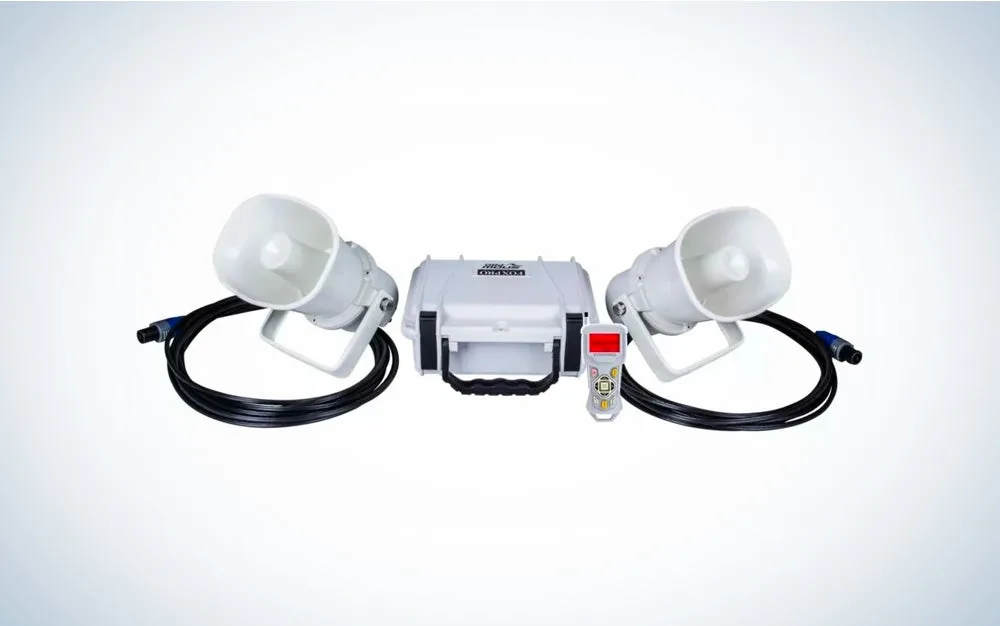
Foxpro has made electronic callers for predators for years, and they bring that experience to this goose caller. It comes with 39 pre-loaded snow goose sounds and two speakers, and you can attach four more for extra volume.
Budget Choice: Homemade Caller
No commercial call is cheap. Google “Make your own snow goose e-caller.” Buy or scrounge amps, speakers and wires, and a plastic tool box for the amp. Load a snow goose call app onto your phone. Plug the phone into the amp. Hit “play.”
The Best Shotguns for Snow Goose Hunting
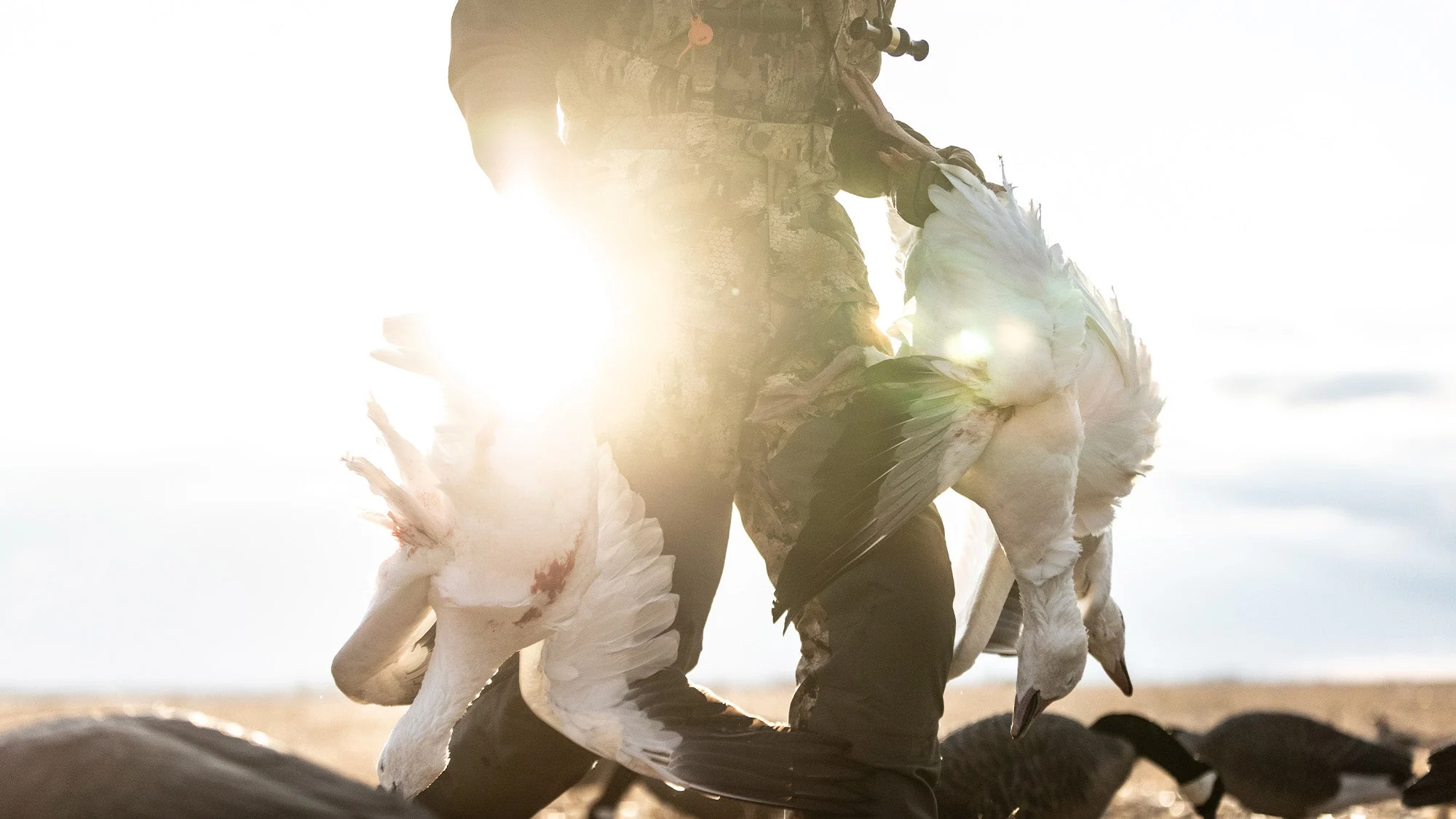
Early in the season, when adult geese make up the bulk of migrating birds, you’ll often need to shoot geese at longer ranges over the top or as they slide. Later in the year, when the inexperienced juvenile birds migrate you have a better chance of good shooting at decoying birds up close.
Shoot a 12. It’s good to have a gun that can reach out. Modified is a good compromise choke for long and close shots. Or, pack an Improved Cylinder and Improved Modified in your blind bag and be ready to switch depending on whether adults or juvies show up.
Your gun should be reliable, and it will have to shoot when it’s dirty. If a snow goose field isn’t muddy, it’s dusty. Bring a can of G96 and give the gun a spritz if the action slows down. You’ll want to add a 2 or 3 magazine extension for snow goose season, too. Carlson’s offers extensions for many popular guns.
Stoeger 3500 Snow Goose

The 3500 Snow Goose is a 3½-inch inertia gun that comes ready for the field in a coat of distressed white Cerakote, extended chokes, a magazine extension, and a spiffy paracord sling.
Read Next: The Complete Guide to Hunting Geese
The Best Ammunition for Snow Goose Hunting
The conservation order not only allows no limits and unplugged guns, it allows extended magazines, too. You may shoot a lot, and you’ll be shooting at angles, like straight overhead, where you’ll really feel recoil. So, skip the 3½-inch shells and super-high velocity stuff. You don’t need it, anyway.
Deluxe Choice: Apex TSS/S3 Blend

The 3-inch, 12 gauge blend load contains an ounce of BBs and a quarter ounce of smaller TSS pellets to fill up your pattern. It’s pricey, especially for high-volume shooting, but it really works.
Budget Choice: Federal Speed Shok

The choice of many budget-minded hunters, “Blue Box” Federals, was already good before they received a makeover. Now, they have better powders, primers, and shot, and they still cost under $20 a box. What more do you want? Shoot the 3-inch BB, No. 1, or No. 2 load at 1450 fps.
FAQs
Q: How many decoys for snow goose hunting?
Hundreds. At a minimum, you should plan for around 500 decoys. Some snow goose hunting spreads number in the thousands. But you shouldn’t let this discourage you from getting started. Focus on buying budget decoys, like windsocks, and teaming up with some friends. Year after year, buy a few more decoys. Before you know it, you’ll have quite a flock.
Q: Where is the best snow goose hunting?
According to harvest numbers, California the best state to hunt snow geese. Runners-up include Texas, Arkansas, Colorado, Louisiana, South Dakota, North Dakota, Kansas, and Washington.
Q: Why are snow geese hard to hunt?
Snow geese learn quickly and can get wise to hunters. Flocks are also full of older, experienced birds who’ve seen a lot of hunting seasons. They also travel in huge flocks. The more eyes in a flock, the more chance a hunter has of getting busted.

